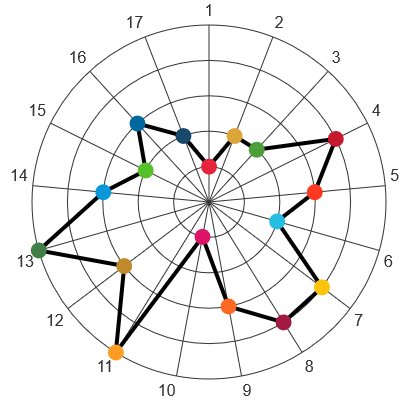
Sustainable Development Goals Barometer
August 2021 – Version 2
Welcome to the Sustainable Development Goals Barometer (SDG Barometer), a dialogue tool aiming to secure a focus on sustainability in building, tender and competition programmes.
The goal of the SDG Barometer is to clarify the client’s sustainability profile, both at a strategic level and in relation to specific projects. It is designed to be used mainly by building clients and client advisers as a dialogue tool to facilitate a deliberate and consistent focus on the 17 SDGs, based on the notion that sustainable results require a holistic effort.
How to use the dialogue tool
The SDG Barometer visualizes the client’s sustainability profile based on answers to 17 questions and ratings of up to 17 strategic goals, each relating to one of the SDGs. Each strategic goal is outlined in a brief text and rated on a scale from 0 to 5. A 0-point rating is visually plotted in the middle of the diagram and indicates that the client does not find it relevant to prioritize that SDG in the given project. A 5-point rating, on the other hand, indicates that the given SDG is a top priority in the context and is plotted on the outer circle of the diagram. The total sum cannot exceed 50 points, so it may be necessary to revise ratings during the process. The goal is not to make every SDGs a top priority but rather to take a holistic approach with specific priorities.
Since building and construction projects can differ widely in focus, it should be noted that it may not be relevant to score all the SDGs, provided any omissions are based on a deliberate, holistic consideration.
The visible result of the process is a diagram in the shape of a ‘barometer’ that illustrates the relative positions of the 17 SDGs and visualizes the client’s SDG profile for the specific project. This barometer can guide the project development for client advisers or teams participating in a tender/competition programme.
Strategic goals, sub-goals and criteria
To facilitate rating and dialogue about the SDGs, the instrument includes selected examples of strategic goals, sub-goals and criteria related to the individual SDGs. These examples are designed to clarify the intentions behind the rating and serve as inspiration for the client’s own descriptions. These descriptions can in turn be incorporated into building, tender and competition programmes that reflect the sustainability profile. After completion of the questionnaire, the client’s descriptions and the generated diagram can be compiled into a report.
About the barometer
The SDG Barometer was developed by the Danish Association of Architects and the Danish Association of Construction Clients. The questions and sample answers draw on inspiration from the UIA SDG Dhaka Declaration and the Manifesto of the Danish Association of Construction Clients. The SDG Barometer is made available to the building industry free of charge and without liability for the two associations. For additional information, please contact the Danish Association of Architects or the Danish Association of Construction Clients.
↓ Download text file with example (Word)
↓ Download blank barometer (JPEG)
If you have any questions about the use of the SDG Barometer, please contact:
Head of Development Dorte Sibast, ds@arkitektforeningen.dk, +45 2671 9017, arkitektforeningen.dk (Danish Association of Architects)
Head of Projects Graves Simonsen, gks@bygherreforeningen.dk, +45 2030 2750, bygherreforeningen.dk (Danish Association of Construction Clients)
The SDG Barometer is made available to the building industry free of charge and without liability for the Danish Association of Architects and the Danish Association of Construction Clients.
© Danish Association of Architects and Danish Association of Construction Clients